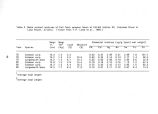| OCR Text |
Show Table 8. Proposed bacteria monitoring schedule for heavily- used beaches in Glen Canyon National Recreation Area. Objective Frequency Sites ( No. of samples) Parameters Intensive transect sample to define bacterial distribution pattern. Six transect periods; two during low use, four during heavy use. Lone Rock ( 15) Moqui Canyon ( 15) Bullfrog Creek ( 15) Farley Canyon ( 15) Fecal coliform, fecal streptococcus*, total coliform*, temperature, pH, turbidity, specific conductance * test in every third sample IV. B. 2. Shoreline water quality. A two- season investigation of bacterial distribution patterns at heavily used beaches is proposed ( Table 8). This study would be accomplished using the established laboratory in the recreation area. It employs a stronger study design to allow a more thorough statistical analysis of bacterial distribution, and would help determine the causes of contamination. IV. B. 3. Springs, seeps, and waterpockets. A two- phase research project is proposed to supply baseline data on springs and seeps in the recreation area. In the first phase, chemical analysis of spring waters begun by Williamson ( 1985) would continue through identification of additional springs and seeps, chemical analysis for cations, anions, and trace elements, and measurement of discharge. The chemical baseline phase would be completed when chemical profiles are completed for each selected spring during seasonal low flows and seasonal high flow. Several of the springs studied by Hand ( 1979) would be revisited to check for long- term changes in chemical makeup under normal conditions. Investigative priority for different areas would be assigned based upon the existence of mineral lease proposals or other development potential. This project could be carried out as a multi- park study in conjunction with other NPS units investigating waterpockets, such as Capitol Reef National Park. The second phase of the proposed research is the biological inventory of springs, seeps, and waterpockets. A particular focus of this study would be an inventory of the vertebrate and invertebrate aquatic life of these water resources. This phase of the research would have a very high interpretive value and may result in the detection of rare or unusual life forms in the NRA. IV. B. 4. Water resources as habitat for fish. A study of Lake Powell's primary productivity, nutrient status, and zooplankton populations is proposed. The research probably could best be accomplished as a 12 |








































































































